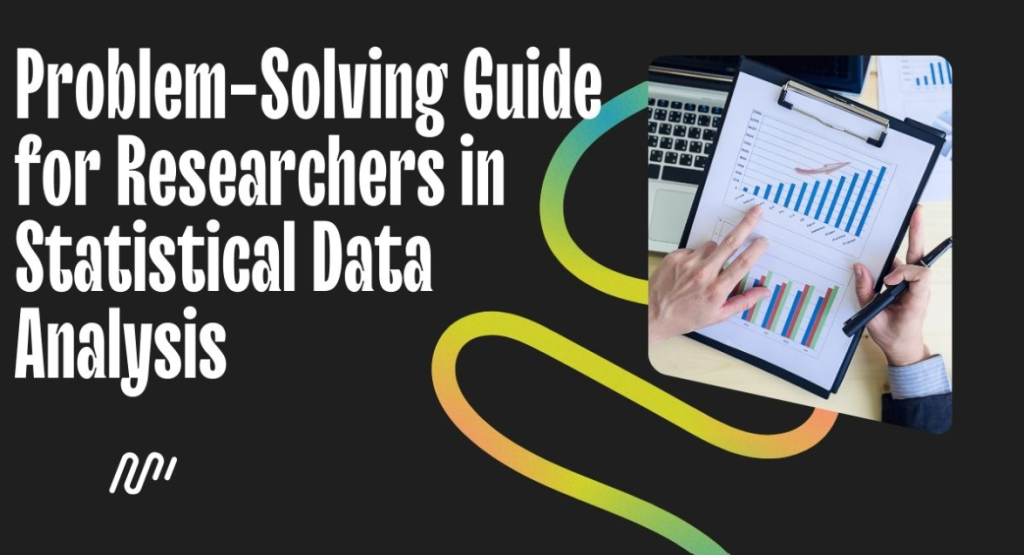
Statistical data analysis plays a vital role in modern research, transforming raw data into meaningful insights. This guide helps the researchers to go through the complexities of statistical analysis from defining research problems or concluding results.
Statistical analysis is collecting and analyzing large volumes of data to identify trends and develop valuable insights. In the professional world, statistical analysts take the raw data to determine the correlations between variables for the patterns and trends to relevant stakeholders.
The structured problem-solving approach ensures that researchers can get an accurate answer by using appropriate statistical methods and answering the research questions effectively.
For more ideas on problem-solving and how to apply appropriate solving techniques to research problems, then continue reading this guide.
Understanding the Research Problem and Statistical Analysis
A research problem is a well-defined question that tells what is found for effective statistical analysis, enabling researchers to draw meaningful conclusions. This research question helps to identify relevant variables and choose suitable statistical analysis methods.
Statistics is a scientific field that involves data collection, interpretation, and validation. Statistical data analysis is a quantitative research process used to quantify and analyze data. Often involving descriptive or observational data.
The use of any statistical analysis for a well-defined research question is necessary. It is the starting point for determining the data that will be collected, the statistical techniques to be used, and the hypothesis to be tested.
Also, this process ensures the appropriate use of data collection, analysis, and interpretation techniques to answer research questions systematically and accurately.
Data in statistical analysis can be either univariate or multivariate. Univariate analysis is applied to single variables (using the t-tests, and ANOVA test). However, multivariate analysis is used for multiple variables performing regression analysis, factor analysis, and discriminant analysis.
Steps to Perform the Analysis & Solve Statistical Problems
Statistical data analysis involves a series of patterns to transform raw data into meaningful insights. For this, some steps adopted to perform any analysis and discussed below clearly:
- Define Research Question or Hypothesis
Defining the research problem is the first and most important step in performing any statistical analysis. To define any problem involves:
- Clearly Define the Problem: Define correctly what you want to investigate such as “How do interactive learning techniques improve test scores in mathematics for high school students?”. A clear, concise question helps to stay focused and guides to collect the data or the statistical methods that can be used.
- Formulate a Hypothesis: A hypothesis is a statement that proposes a potential answer to your research question. It consists of:
- Null Hypothesis (H0): Indicates no effect or no relationship such as “There is no significant difference in test scores between high school students who use interactive learning techniques and those who use traditional methods”.
- Alternative Hypothesis (H1): Indicates an effect or relationship “High school students who use interactive learning techniques score higher test results mathematics compared to those who use traditional teaching methods”.
- Collect and Prepare Data
To conduct any statistical analysis, collect or prepare reliable data. The data preparation involves multiple steps:
- Gathering Data: Collect data from given research questions and gather the self-reported information. Use the controlled studied variables to solve the observed data effects.
- Data Cleaning: Correct the typographical or logical errors in data entries and use imputation techniques, like mean substitution or regression, to deal with incomplete data. Standardize the formats by using the categories or units of measurement to make data consistent.
- Organize the Data: Structure the cleaned data into formats like spreadsheets (Excel, Google Sheets) or databases (SQL) to make further analysis easier. Also labeled well-defined headers with the variable or group name.
- Explore the Data (Descriptive Statistics)
To explore complex analysis, first find some necessary terms of the data set using descriptive statistics. This method helps in understanding the shape, spread, and main patterns of sample/population data.
It also helps to identify irregularities, such as skewness or the presence of anomalies, which can inform the type of analysis. For an understanding of descriptive statistics see the below details:
- Evaluate Summary Statistics: First find the mean, median, and mode of the given data set in performing any statistical analysis. These measures give an initial sense of any data distribution data set. Then find the range, variance, and standard deviation to determination of the separation or dispersion of the data set.
- Data Visualization: Use the technique for the visualization of data that is useful for showing frequency distributions. For this, draw the different types of graphs (Histogram, Pie chart, Box Plot, Scatter plot, etc.,) that make the visualization process more effective. Box Plots help in the visualization of the separation or identification of outliers. While Scatter Plots show the relationships or trends between two variables.
- Choose the Right Statistical Methods
The choice of statistical methods depends on the type of data and the nature of the research question. For statistical or continuous and categorical data adopt different techniques. The choice of technique is necessary for the exact or effective answer to the research question.
- Identify Data Type: The Categorical Data is represented in distinct categories or distinct values (i.e., gender, yes/no responses). While the Continuous Data can take on an infinite number of values or data observations from the experiment.
- Select Statistical Techniques:
The selection of any statistical technique depends on the data or nature of the experiment. The selection of the right technique is necessary for the exact or accurate answer to make the results of any data effective.
For the selection of technique or analysis see below details:
- T-Test: To compare the means of the sample/population data of two groups perform the T-test. If the groups are statistically significantly different from each other. A significant p-value (usually < 0.05) indicates the statistically significant difference between the two group means.
- ANOVA (Analysis of Variance): If one group’s mean is different from the others then to compare the means between more than two groups use the ANOVA test. The Post hoc tests (Tukey’s HSD) are used to identify the groups that differ from one another.
- Regression Analysis: To investigate the relationship between one or more dependent and independent variables then perform the regression analysis. It allows the predictions and understanding of relationships.
- Chi-Square Test: For categorical data, test the association between two variables. The Chi-Square statistic quantifies the difference between the observed and expected frequencies.
- Correlation: To find the strength and direction of a relationship between two variables perform correction statistics. The correlation coefficient (r) ranges from -1 to 1. A value near “1” shows a strong positive correlation, “-1” represents a negative correlation, and “0” means no correlation.
- Conduct the Analysis
After selecting the technique according to the right statistical methods then performing the analysis for the numerical value of any data. The right tool is more beneficial for the exact value of any data.
Below we discuss some tools that are more beneficial to conducting the analysis and determining the numerical value of any data.
- Statistical Software: To perform the statistical analysis use software like SPSS, R-software, Python (SciPy, Pandas), or Excel to conduct the selected test. First, download this software on your devices and use it. Set down key settings, parameters, and according to the software used for the analysis. Make sure the correct parameters are set like confidence levels (usually 95%) or significance levels (typically 0.05).
- Statistical Tool: Use standarddeviationcalculator.io to find the value of any data. It is an online platform that provides different statistical tools such as Standard Deviation Calculator, T-Test Calculator, ANOVA Calculator, Regression Analysis Calculator, Chi-Square Test, and many others. These tools help to find the numerical values of different data by just entering the data according to the input. Also, helping to make graphs (such as histograms, Pie charts, and Distribution graphs) that make statistical analysis easy.
- Interpret the Results
After finding the values of data, analyze the results to understand the statistical outputs. See the below details:
- Review Key Metrics: Note the P-value and determine whether to reject the null hypothesis. A “p-value<0.05” typically indicates the significance of given statistical data. Also, note the Confidence Intervals to assess the reliability of estimated results by giving a range where the true population parameter is fall.
- Interpret Results: First note that the finding results support or reject the null hypothesis. If the result supports then select the null hypothesis and not then move to alternative hypothesis. Ensure the findings are related to the original research question.
- Make Inferences and Recommendations
- Draw Conclusions: Based on the statistical output, infer what the data is telling about the population or other phenomenon.
- Provide Recommendations: Based on findings, suggest actions or implications.
- Limitations: Note the limitations of analysis, Due to sample size, sampling method, or data collection constraints. This helps contextualize the validity of your recommendations.
Conclusion
Statistical data analysis is crucial in the modern research process to transform raw data into valuable insights. By understanding the research problem, applying appropriate statistical techniques, and maintaining the standards of methods, researchers can derive meaningful insights from their data.
This problem-solving guide helps the researchers to navigate the complexities of statistical analysis, from defining research problems to concluding. By this guide understands the research problem, statistical data analysis, steps to analysis, choosing suitable statistical methods, conducting the analysis with the right tools, and interpreting results.
By these steps, researchers can make informed decisions and draw meaningful conclusions through statistical analysis.



